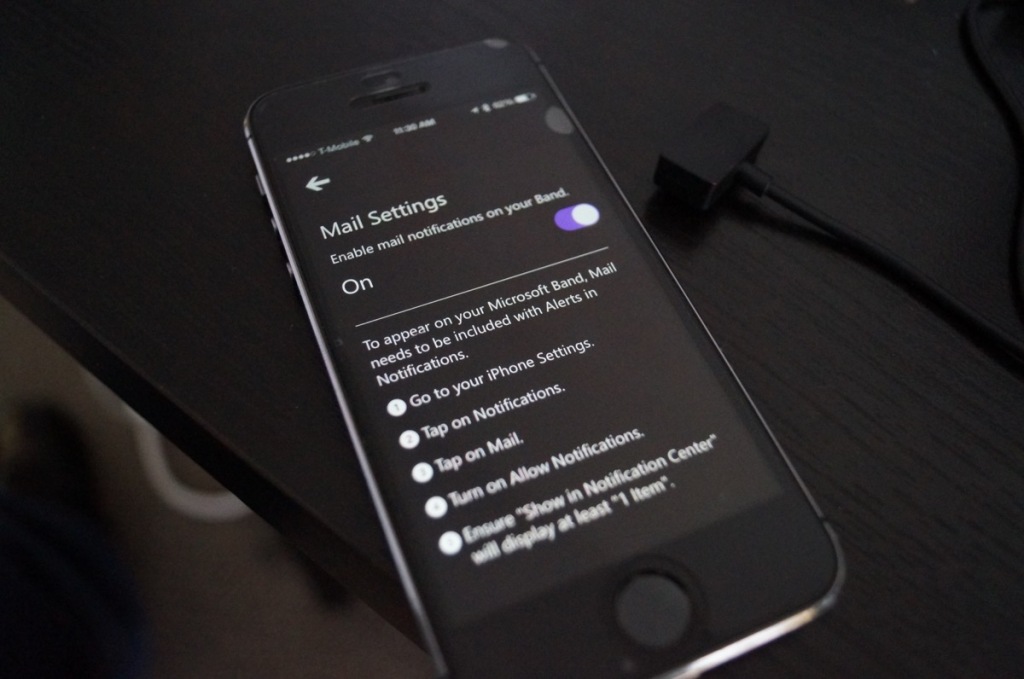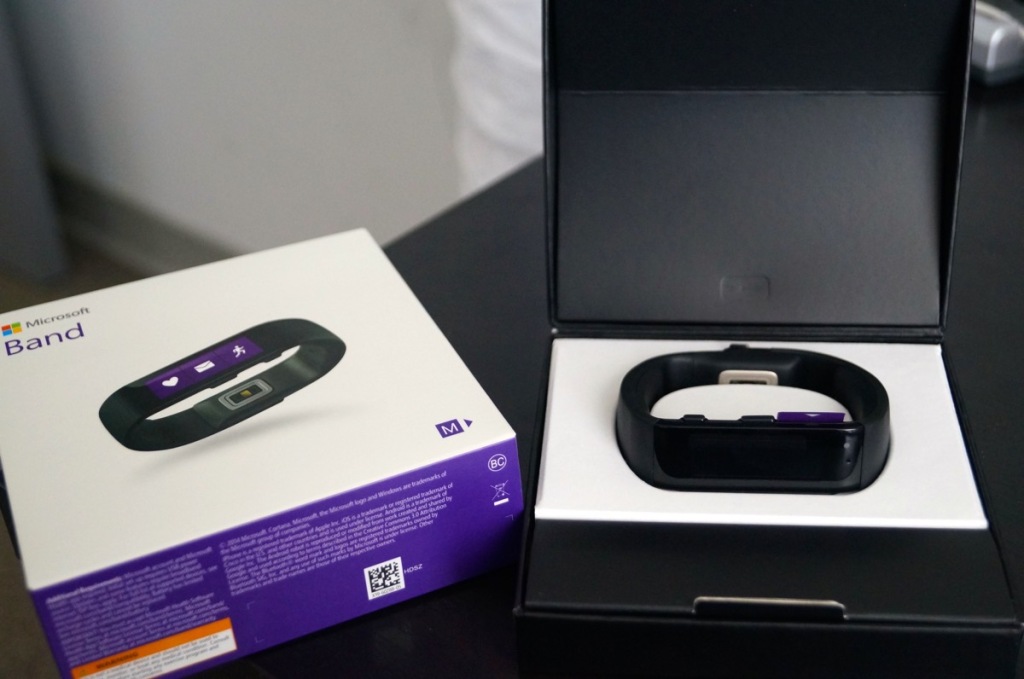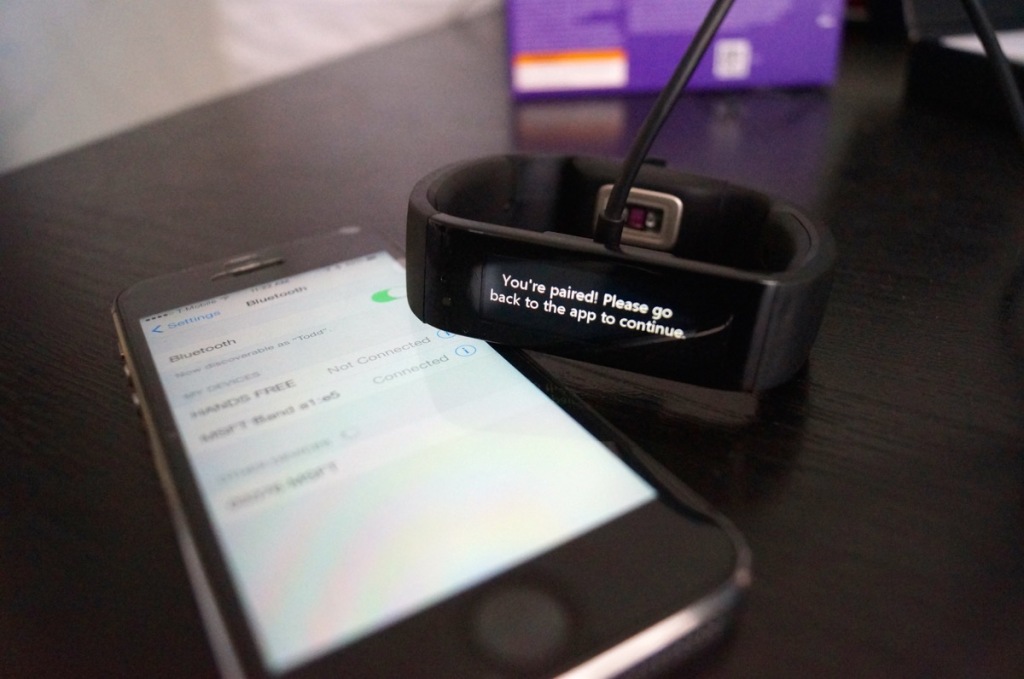
OK, so Microsoft has a new wearable fitness tracker and smartwatch. Whoop-dee-doo. Join the club.
That’s the understandable reaction from some corners of the tech world this morning, but I’ve gotta say, I’m excited to give this thing a try. I’ve been using a Microsoft Band for a grand total of three hours so far, and already I’m seeing some things that could add some value to my life.

But is it really worth $199?
That’s the underlying question I’ll be attempting to answer in a series of posts in the coming weeks on GeekWire about my experience with the Microsoft wearable, starting with this one. I’m using a review unit, on loan from Microsoft, and when this thing goes back to its home in Redmond, I’ll decide for myself whether it’s worth almost $200 of my own money to go into the store and buy one.
Along the way I’m going to see if I can become healthier, as indicated in part by weight loss. I’m 6-foot-3 and pushing 240 pounds, and I’d love to get back down to 205, my weight prior to becoming a dad and co-founding GeekWire.
Let’s see if this job can do good things for my health, for a change!
First impressions out of the box
If you’re just tuning in, Microsoft Band is a fitness tracker with 10 sensors, plus light messaging and communication features. It also has the ability to connect with the Microsoft Health platform with the long-term promise of using machine learning to provide insights into your personal health, such as how aspects of your schedule might be affecting your sleep or overall health.
Out of the box, the Microsoft Band feels like a high-quality device, with a hardened plastic band and an adjustable clasp. It can be worn face up on top the wrist, like a traditional watch, but the horizontal orientation of the screen actually makes it a little awkward to wear that way.
The Microsoft team behind the device tends to prefer the under-the-wrist approach, and the screen orientation actually makes that feel more natural for a quick glance by simply lifting up and twisting your hand.
 The device comes in three sizes — small, medium and large. There’s a sizing chart on the side of the box to help. Even though I could have gone with a large, I was close to a medium, and the Microsoft team advised to err on the smaller side, to make sure that the device would fit snugly enough to pick up my heart rate.
The device comes in three sizes — small, medium and large. There’s a sizing chart on the side of the box to help. Even though I could have gone with a large, I was close to a medium, and the Microsoft team advised to err on the smaller side, to make sure that the device would fit snugly enough to pick up my heart rate.
I’m pretty happy with the size and the fit. To me, it’s comfortable on the wrist, although I will say that I’ve worn some large watches in the past. My colleague John Cook’s first comment was that it seemed clunky and too large, although he has never been a fan of wearing any type of watch.
After years of going without a watch, I am struggling a bit to adjust to typing with something on my wrist. One early lesson that I just learned: If you wear it using the under-the-wrist approach when typing, it’s easy to scratch up the bezel around the screen. I’ve started flipping it around to the top of my wrist when typing as a result.
The Microsoft Band has a touch screen, with two hardware buttons at the bottom of the display, a power button and an action button whose purpose varies depending on the mode. For example, the action button toggles through heart rate, steps, miles and the date on the home screen, or can be used to signal the start of a workout in the exercise mode.
When I’ve used Microsoft’s Surface tablets in the past, one of my biggest complaints has been the difficulty trying to connect the charging cable to the device. Thankfully Microsoft has figured that out with the Microsoft Band charging cable, which snaps neatly onto the back of the screen.
Here’s a gallery of pictures from the unboxing experience.
Cross-platform compatibility
One of the most refreshing things about the device is that it works across devices, with companion apps on iOS, Android and Windows Phone. It also can connect to fitness and health tracking apps such as MyFitnessPal and RunKeeper, and the Microsoft Health platform will work with other devices such as UP by Jawbone.
 This is really where this device is an example of the “New Microsoft” under CEO Satya Nadella. In the old days, this might have worked with Windows Phone and Windows 8.1, and that’s it. Of course, with single-digit market share for its smartphone OS, Microsoft wouldn’t have the luxury of going that route even if it wanted to.
This is really where this device is an example of the “New Microsoft” under CEO Satya Nadella. In the old days, this might have worked with Windows Phone and Windows 8.1, and that’s it. Of course, with single-digit market share for its smartphone OS, Microsoft wouldn’t have the luxury of going that route even if it wanted to.
I was able to pair the Microsoft Band easily with my iPhone 5S, and I immediately started receiving text messages, calendar information and emails. On the iPhone, the Microsoft Band connects to the iOS Notifications Center, so you’re essentially seeing what would otherwise appear in alerts on your phone. The Microsoft Band buzzes when an appointment alert comes in. Using the settings in the app, you can change the color and other aspects of the display on the band.
When connected with a Windows Phone, the device also integrates with Microsoft’s Cortana digital assistant.
Integrated apps and features
The companion smartphone app provides a dashboard with your personal metrics including steps taken and calories burned, in addition to the results of your workout and many other pieces of data. The companion desktop app is for syncing and updating the device, not a dashboard viewing data, but the company says it will have a companion web site available in December.
 Microsoft says it has achieved some technical breakthroughs with the device, using GPS to ensure an accurate calculation of stride length and step count. Microsoft Band can also tell you how many fats vs. carbs you’re burning during a workout, and details about your nightly sleep, including your sleep cycles. Other neat tricks include a UV sensor that can you when you’ve been out in the sun for too long.
Microsoft says it has achieved some technical breakthroughs with the device, using GPS to ensure an accurate calculation of stride length and step count. Microsoft Band can also tell you how many fats vs. carbs you’re burning during a workout, and details about your nightly sleep, including your sleep cycles. Other neat tricks include a UV sensor that can you when you’ve been out in the sun for too long.
You can track your workout and also follow guided workouts included with the smartwatch.
There’s a built-in app for runners but not specifically for cyclists. Microsoft says it will continue to add features steadily over time, and it’s clear that cycling is on the roadmap. The device is water resistant but not waterproof, so swimmers are out of luck.
(This is actually a bit of a bummer for me, because swimming and riding a stationary bike are two of my favorite exercises, but maybe it’s a good thing because it could break me out of my mold.)
Those are just a few of the features and apps. There’s going to be a lot to dig into in the coming days and weeks. I’m looking forward to trying this thing out and posting about my progress.
Next up, I’m going to get MyFitnessPal going and connected to the Microsoft Band. Later on I’ll be hooking up my Starbucks account to this thing and trying to buy a cup of coffee with it. (Yes, you can.) No sugar or cream, of course, if I want to keep on track with my fitness goals. Stay tuned.














